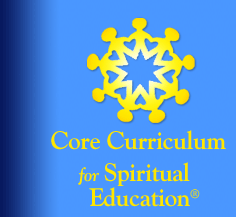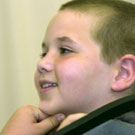Success Stories
Success Stories
Success Stories
Many teachers and parents have discovered how the Core Curriculum can enhance classes for children and junior youth and, indeed, transform communities. Every community has unique qualities, and the flexibility of the Core Curriculum generates success in different ways. Some of these success stories are related below.
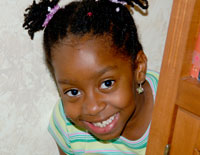
Beginnings of the Core Curriculum
Bahá’í Schools
Neighborhood Classes
International Successes
Beyond Children's Classes
These stories will be updated from time to time. If you have a story to share, send us an This e-mail address is being protected from spambots. You need JavaScript enabled to view it . We’d love to here from you!

Download a flyer you can duplicate!
Print this tri-fold brochure, add your community’s contact information.
Beginnings of the Core Curriculum
For almost two decades, the Core Curriculum has provided a comprehensive and nurturing foundation for Bahá’í classes of all sizes in the United States and elsewhere. Beginning in 1988, under the guidance of the National Spiritual Assembly of the Bahá’ís of the United States, a National Education Committee researched the Bahá’í writings, held extensive consultations, reviewed educational materials and curricula, and assessed all available Bahá’í educational materials. The Core Curriculum was created to address these issues:
• The needs of the age require a curriculum for the full age spectrum: birth to maturity.
• A Bahá’í education and training curriculum is an ever-changing process responding to humanity’s evolving understanding of the Revelation of Bahá’u’lláh.
• Bahá’í education and training requires involvement of parents, teachers, institutions, and the entire community in a unified manner.
• Guidance for teachers and parents about how to raise children who are free from prejudice is a necessary part of a Bahá’í education program.
Initially created as a program for children ages 6–12, it quickly became evident that the chosen learning framework offers strategies for serving all ages and levels of spiritual maturity within the same learning process. Thus, in addition to children’s education, the development of the Core Curriculum has given rise to a comprehensive program for training and community development. The Core Curriculum, which is a process to study and apply the Bahá’í Writings to daily life, is designed to assist in the transformation in the whole character of humankind, through touching the hearts and minds of the next generation and providing the means for their continued development.The refinement and continuing development of the Core Curriculum is led by the National Bahá’í Education Task Force. Current members of the Task Force include Dr. Barbara Johnson, Dr. Saba Ayman-Nolley, Ms. Joannie Yuille, Dr. Ray Johnson, and Ms. Nancy Davis.
topBahá’í Schools
Palm Beach County North, Florida
This Core Curriculum based school is in itself an inspiration to all and is inspiring people to arise to become teachers. The school has 50 children, and all teachers are using the Core Curriculum. The substitutes are trained in the Core Curriculum also. The parents love all the science elements of the curriculum. Last summer, at the close of the school for the summer break, a ceremony was held for the children and teachers. Afterwards, the mother and older sister of one of the children approached a teacher and said, “we want to be a part of this.” So they took the teacher training course and now the mother is a teacher and the sister is a substitute at the school.
Durham, North Carolina
The Carlotta R. Holmes Bahá’í School has been around for quite some time. However since 2001 the curriculum was switched to the Core Curriculum. The teachers became very excited after a Teacher Training in the Fall of 2002 and the number of Core trained facilitators as well as the number of Core trained teachers and trainers quickly quadrupled to 400%! This was just the beginning.
Over the next few years, as we in the Triangle became the fourth A-Cluster in the country, it was imperative to assure that the school program was truly “open to all.” We moved from a simple curriculum of the Central Figures to a combined Oneness and Central Figures curriculum, with a teacher for Oneness introductory lessons and a teacher for Bahá’u’lláh or The Báb serving in side-by-side classes for each multi-age grouping of children: 5–8, 9–11, and 12–14. We asked everyone to bring friends to the school and also practiced techniques of welcoming new children to the class each week to avoid issues of past history where new people had not felt as openly welcomed. There was great energy in the school. The parents and other adults were also receiving Fundamental Verities class lessons at the same time, with easily 50 plus children and 50 plus adults in attendance each Sunday.
The School Committee adopted a standard of having every class with two trained teachers in support of the National Guidelines for the Safety of Children prepared by our National Spiritual Assembly. Each year trainings continued for the teachers and even the nearby school in Raleigh, North Carolina, was equally well served. By 2005 we had two exciting schools with a full Core Program and over 40 Core trained Teachers and 14 Core Curriculum Trainers in our one cluster!
As we evaluated and extended our plan for the children to include two strands of the curriculum each year, we developed classes of teaching teams for the Oneness strand and for the Central Figures strand and they alternated weeks with their classes, so the children would have Oneness for two weeks of a month and then study the life of the Manifestation for the other two weeks. This became a successful pattern and has continued as long as the supply of teachers kept expanding. The classes became large and we divided the classes into smaller age groups: age 3, age 4, grades K–1, grades 2–3, grades 4–5, junior youth, and youth. We have also pioneered the pre-school curriculum units and the Youth Empowerment programs in various years.
It has been a popular and joyous school experience for all of our children and their friends. The area Spiritual Assemblies were also wonderfully supportive and many assembly members were trained in the curriculum, using its powerful style to enhance many of the other core activities in our area. It has been a joy to see all our children raised with such happy excitement in this excellent curriculum.
Boone, North Carolina
In the younger class there are nine children, and only one is a Bahá’í child. The classes are still using Core Curriculum, and in the one class the teacher’s husband is from Australia so in the class they are using pieces of the Australian Peace Pack also. The children that they have in their classes are from their efforts to attract their friends and neighbors to Bahá’í classes open to all. These parents were searching for spiritual education for their children and the Bahá’ís stepped in. The classes are showing more promise these days because the parents are getting more involved. The school is offering mini-seminars for the parents about the Core Curriculum teaching methods.
Detroit, Michigan
The Detroit Bahá’í School, now known as the Doris Paulos School (since 1984), has been in operation in Detroit since 1970 and very possibly since the 1950s. It has adopted Core Curriculum material for all children and youth classes. The response was wonderful. Within the first year the number of students doubled from 30 to approximately 60 children/youth. This increase occurred without any formal advertising.
When the National Spiritual Assembly asked the friends to provide an atmosphere for growth, the Detroit Local Spiritual Assembly responded by taking the Ruhi study circles, supporting the Core Curriculum children’s classes, and honoring the efforts of the friends.
In 2005 the numbers continue to increase. Many more children from outside the Bahá’í community attend, especially grandchildren of the Bahá’í elders. The 2004-05 school year was divided into two semesters based on Core Curriculum material. The first semester focused on The Love of Bahá’u’lláh and the second semester focused on the Oneness strand. The school continues to grow and thrive. This process includes strong support from the Detroit LSA and a dynamic multicultural, intergenerational approach to devotions and learning.
Wilmette, Illinois
We started our children’s class with five children. Our teaching staff grew from three to six by the end of the year, thanks to all the intensive training going on! Two of us had Core Curriculum training, and the rest had Ruhi Book 3 training. We all used the Core Curriculum Lesson Planning Guides all year long, and the children and teachers had a lot of fun. Two of our Ruhi trained teachers were youth, and both said that they found the Lesson Planning Guides very helpful and easy to follow. I heard from the parents that their children were very pleased with the classes, and for the first time were eager to go to children’s classes. One of the great anxieties of the parents was that we not make the classes “boring,” and that we incorporate a lot of diverse activities to engage the children. I assured them that they need not worry as diverse activities were built right into the curriculum.
We have grown to three classes with 22 children and junior youth. More than half our teachers have Core Curriculum training, and the rest are receiving it this month. Still, we use the Lesson Planning Guides, and the one lead teacher without any Bahá’í teacher training (Ruhi or Core) has been singing the praises of these lessons. Some of our new parents expressed similar anxieties about the quality of the classes that we heard from parents last year. Now, parents are all expressing their gratitude, and tell us that their children are excited about coming to class each week.
Teachers are also very happy and feel supported by the structure we have put in place. At the beginning of the year, I provided each teacher with a proposed schedule of lessons, utilizing the lessons in the Lesson Planning Guides. I gave each teacher an opportunity to make alternate suggestions, but none did. Each month, teachers tell us exactly what supplies they will need for their lessons, and we purchase them in advance and have them available when they arrive in their classes. We also serve lunch at the end of the morning (since our classes end at noon). This provides an important time for the teachers, parents, and children to get to know each other better in an informal setting. Parents volunteer to provide and serve this lunch. The Wilmette LSA has approved a budget for classroom supplies, and we meet in their Bahá’í Center. Parents have contributed enough money to cover the costs of lunches for the year, so that when parents volunteer to serve lunch, they may be reimbursed according to the budget we have set.
topNeighborhood Schools
A family with two children started attending children’s classes in the fall. They are not Bahá’ís. This family has two adorable children, a four-year-old boy and a six-year-old girl. The little boy has difficulty learning and connecting with people. Each week, the mother brings them to class and waits for them until the class is over. One day the mother came up to one of the Bahá’í school teachers and told her this story. “Last night I went in to my son’s room to check that he was asleep. As I leaned down towards him I could hear this little voice singing ‘Shine your light on me, Bahá’u’lláh. I‘m over here, Bahá’u’lláh.’” The mother says that she realizes how much he is learning and connecting very deeply with what matters the most.
Scottsbluff, Nebraska
Starting with one child four years ago, a teacher trainer in Scottsbluff now has between 8 and 16 children attend on a regular basis her Saturday Bahá’í classes. She is very excited because she now has a core group of children who are returning each year, and she is noticing more parent involvement. She and her helpers pick up the children from their homes. She learns a lot about the children on the ride to her house. She does home visits with the children, especially new attendees. She is getting to know the parents very well and establishing friendships with them. When she drives a child home she might stop in and see the new baby or just check in with the mom to say hello. Right now she is in the midst of more home visits, just to check in and let the parents know what their children are doing.
This year she has taken lessons from the Oneness Lesson Planning Guides and also from the Central Figures—learning about Baha’u’llah ‘Abdu’l-Bahá, and focusing on the virtue of nobility. With the assistance of her husband and three friends she is now doing two classes, one with 10–12 children up to age ten and a group of about six children ages 11–13. Most of the children are not Bahá’ís. One of the friends serving as a helper with the Bahá’í children’s classes is a recently declared Bahá’í. Another friend also helping with the classes is getting close to the Faith as well.
She also takes advantage of opportunities in the larger community. There is a community college nearby and she called the college and explained that the children in her classes belong to one big world family and that they wanted to get to know more of their world family. She has had college students from Afghanistan, Japan, China, Ecuador and Venezuela visit her classes. She says the Lesson Planning Guides are full of ideas like this.
She also puts on a summer virtues camp. This June will be its third year. At the parent’s night after last summer's virtues camp, almost all of the parents attended.
Marlborough, Massachusetts

These photos show a junior youth class using a Core Curriculum Level Three activity. This was a science experiment using optics (light and shadow), demonstrating 1) that darkness is the absence of light, and 2) that the edges of a shadow are sharper the closer an object is to the surface on which the light is projected because the angles of the rays of light are constrained.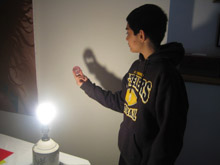 The edges of the shadow become more diffuse as the object moves further away from the surface on which the light is projected, this time because the angles of the rays of light are more numerous.
The edges of the shadow become more diffuse as the object moves further away from the surface on which the light is projected, this time because the angles of the rays of light are more numerous.
This related quotation by Bahá’u’lláh was memorized by the student in one lesson: “The utterance of God is a lamp whose light is these words: ye are the fruits of one tree and the leaves of one branch. Deal ye one with another with the utmost love and kindess, with friendliness and fellowship.”
Salem, Virginia
We started our neighborhood children’s class with three 5-year-old kids, having no experience teaching children. We still have 12 to 13 children who attend on a regular basis, most of whom are not from Bahá’í families. We are using the Oneness strand right now and have two classes and one 14-year-old who helps us with the classes. Something new is that we have a retired chef who comes every Sunday and cooks lunch for the children. They love it and he loves being with the children. I notice that the children are maturing from last year, memorizing more. We did a performance for the parents. We are inviting the parents and the children recite what they have memorized and show them their artwork. We had a cookout. We will continue classes through the summer. We have had several visitors to the classes as well.
We use the Core Curriculum lessons just as they are. I have to say I didn’t have a lot of confidence in the beginning, but I just follow the instructions and you know what? It works! The curriculum really works.
Boone, North Carolina
This community has made efforts to attract their friends and neighbors to Bahá’í classes open to all. In the younger class there is one Bahá’í child and there are eight who are not from Bahá’í families. The classes are using Core Curriculum and in one class the teacher’s husband is from Australia, so in that class they are using pieces of the Australian Peace Pack also.
These parents were searching for spiritual education for their children and the Bahá’ís stepped in. The classes are showing more promise these days because the parents are getting more involved. The school is offering mini-seminars for the parents about the Core Curriculum teaching methods.
topBeyond Children’s Classes
Lincolndale and Peekskill, NY
Susan Cody took the Core Curriculum Teacher Training and absolutely loved it. Her husband, Tom was one of the facilitators for the training. Susan has been a Bahá’í for many, many years and she says that the Teacher Training was one of highlights of her Bahá’í life, both as a deepening and as an enriching Bahá’í experience. It was very uplifting. She had already been teaching children’s classes but this took her to a new level and improved her abilities as a teacher. Currently she is teaching a Bahá’í children’s class and has three grandsons in her class. Her daughter-in-law Ridvan Foxhall is also trained in the Core Curriculum.
In September 2006, Ridvan decided to start a Children’s Theatre Company (CTC), modeled on the Children’s Theatre Company in New York City. She had been studying the guidance of the Universal House of Justice and the National Spiritual Assembly and decided that this would be a wonderful way to reach out to the greater community. Susan is a music teacher so Ridvan invited her to be the Music Director. The Local Spiritual Assembly of Cortlandt sponsored them and the Peekskill Parks and Recreation Department gave them space free of charge and helped them to arrange a performance area.
With Susan’s three grandsons and two other children from Bahá’í families they held an open audition. Their planned advertising was not done in time but just through word-of-mouth 24 children, ages 4-15, showed up. All 24 went on to join the company and stayed for the entire first season.
The format of the Children’s Theatre Company focuses on spiritual education and character development plus performance. The children all learn quotations from the world’s religions, prominent philosophers and great thinkers. All the plays that they perform have a moral base. Besides the character development that the children are engaged in, they learn singing, choreography and stage presence.
Susan became very excited as she started to see that the format of the CTC very much reflected the model of the Core Curriculum. She could see elements of Knowledge, Wisdom, Spiritual Perception and Eloquent Speech throughout the program.
Before a performance the children choose a quote, learn it, write it out and spend time reflecting on what it means to them and then they write their biography and include the quotation and their reflections of what it means to them. All their biographies along with their photograph are on display at each performance.
Susan said the Children’s Theatre Company really reflects the Core Curriculum philosophy in a very refined way and is very inviting to the general population. Parents are very involved at all levels, from set-up and design to clean-up.
Their season ran from September through January. They performed two plays locally during the season and then in February traveled to New York City to join with the New York CTC to perform at the United Nations.
Already many parents are asking about the start up date. They will start up again in the fall.
Chicago, IL
This past fall a new family who are not Bahá’ís started attending local Bahá’í classes —a mother and her two children, a boy and a girl. After attending classes for several months, the mother told one of the teachers that she couldn’t believe how much her daughter had changed and how much she was learning. Her teacher noticed that while the children in their classes were preparing their props for a Naw Ruz party, the daughter first made props for her little brother and then made her own.
Their mother also told the teacher this story: Her daughter was assigned at her public school to choose a historical building in the Chicago area and do a report on it. She chose the Bahá’í House of Worship in Wilmette. Her mother took her there, they took photographs and learned about the House of Worship and then did posters for her school project. While they were there they visited the Cornerstone Room, and the little girl started singing a song about One Family that she had learned at Bahá’í class. She told her mom “this is the way I sing the song for ‘Abdu’l-Bahá.”
Chicago, IL
A study circle here is in the last course of the Fundamental Verities sequence. Recently the study circle participants hosted a devotional meeting. The participants are a very diverse group representing several cultures. There was a woman who has come to some firesides who attended the devotional meeting and brought her husband. The meeting was held on Good Friday. The readings were taken from some of the writings of ‘Abdu’l-Bahá and Bahá’u’lláh about Jesus. Both the woman and her husband were very touched by the readings. They both stayed a while after everyone else had left for the evening. As she was leaving she turned to her hosts and asked “How do I declare my faith in Bahá’u’lláh?”
topInternational Successes
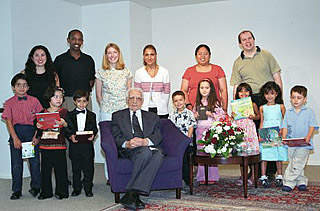
Hand of the Cause of God Mr. Ali-Akbar Furutan with Bahá’í children, their teachers, and their Core Curriculum storybooks, June 2003.
Bahá’í World News Service.
Panama

In December 2004, two Core Curriculum Trainers conducted Spanish-language Teacher Trainer Training at the National Bahá’í Center of Panama. 21 people participated from Panama, Nicaragua, and Costa Rica, including two individuals who were not Bahá’ís. The National Spiritual Assembly of Panama plans to use the Oneness Lesson Planning Guides in their moral education classes in the public schools as well as in Bahá’í classes. The training report in their national newsletter states: “The materials can be used with a non-Bahá’í audience, both because they were developed in an accessible and entertaining manner, and also due to their promotion of the use of the arts and of participatory classes. These materials also seek to awaken the virtues and attributes latent in the children once contact is established with the Revealed Word.”
Italy

Foundations for a Spiritual Education has been translated into Italian as an aid to communities planning Core Curriculum children’s classes. A Core Curriculum training for trainers was held in Acuto in 2002, with attendees from Italy, Greece, Romania, and Albania. In a letter appeciation, the participants said the training “inspired our minds and hearts through the amazingly systematic program for the Spiritual Education of Children embodied in the Core Curriculum.”
Translations
For the past several years a team of dedicated servants has been busily translating Core Curriculum Lesson Planning Guides into Albanian. Another group in the Netherlands has been translating into Dutch. Translation of Teacher Development Workshops has been the most recent work in Spanish. Other work has occurred in French and Russian.
Singapore
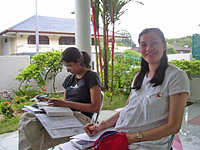
“We are very satisfied with the quality of this curriculum as a Bahá’í curriculum and the progress made thus far. It is a curriculum with a great deal of potential and it is our opinion that we should continue developing and adapting it for the education of children in Singapore.”
top
